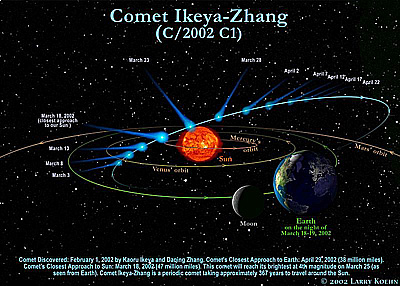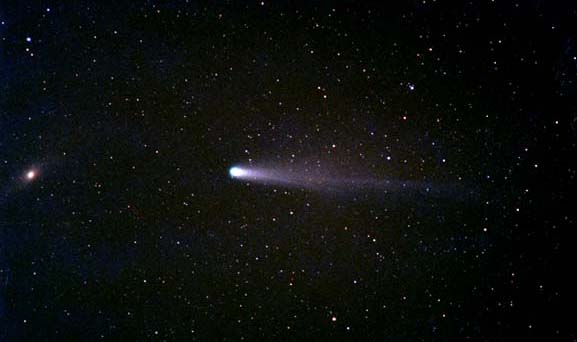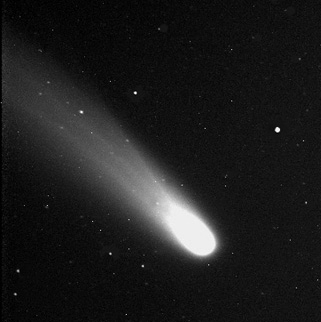COMET IKEYA-ZHANG


* * * SKY & TELESCOPE's SKYWATCHER'S BULLETIN - May 7, 2002 * * *
COMET IKEYA-ZHANG IN THE MORNING SKY
The comet is now between 5th and 6th magnitude as it continues its trek
from Draco to Hercules. For a table and chart showing the comet's current
location,
click here.
What's Up in Space -- 21 Apr 2002
FADING COMET
Although Comet Ikeya-Zhang is approaching our planet, it is also fading as it recedes from the Sun. Astronomer Clay Sherrod reports on April 18 that "Ikeya-Zhang is just visible to the naked eye and has dimmed almost one-half magnitude since April 12." Nevertheless, there's still time to see the comet before it vanishes. Get up before dawn any morning this week and look north between the constellations Cassiopeia and Cygnus; the comet is a fuzzy blob about as bright as a 4th magnitude star.
What's Up in Space -- 8 Apr 2002
MORNING COMET
Comet Ikeya-Zhang, which delighted evening sky watchers last week when it glided by the Andromeda Galaxy, is now visible in the morning sky, too. One of the most photogenic comets in recent memory, Ikeya-Zhang is glowing like a 3rd magnitude star with a long blue tail. You can find it yourself above the northeastern horizon before sunrise; look near the W-shaped constellation Cassiopeia.

Photo: Marco Verstraaten, The Netherlands
April 7, 2002
COMET IKEYA-ZHANG AND THE GREAT ANDROMEDA GALAXY
Northern sky watchers enjoyed a rare treat just after sunset from April 3rd - 5th.
As the sky faded to black, Comet Ikeya-Zhang and the great Andromeda Galaxy met
barely a degree apart in the western sky. The pair, which are dimly visible to the
unaided eye, remain close together. Use binoculars to find them not too far above
the western horizon. In The Netherlands Marco Verstraaten of AstroPAge took this stunning picture
of the comet and the galaxy using a f5.6/300mm telephotolens piggybacked on his
telescope. Exposure: 4 minutes on Fuji 400.
* * * SKY & TELESCOPE's SKYWATCHER'S BULLETIN - April 2, 2002 * * *
BRIGHT COMET MEETS BRIGHT GALAXY
Mark Thursday, April 4th, on your calendar. That evening, weather
permitting, look low in the northwest after sunset to spot Comet
Ikeya-Zhang very near the Andromeda Galaxy (M31). The view through
binoculars or a small telescope should be especially rewarding, as these
two celestial spectacles crowd into the same field of view. More
information about the comet, charts showing you where to look, and a link
to our interactive sky chart that will illustrate the comet's position
through May, is available on our Web site.
Space Weather News for March 31, 2002
COMET CONJUNCTION
Got dark skies? Can you see the western horizon? If
you answered "yes" to both these questions, then you could be in for a
treat just after sunset on April 4th. As the sky fades to black, Comet
Ikeya-Zhang and the great Andromeda Galaxy will meet about 10 degrees
above the western horizon. The pair will be dimly visible to the unaided
eye -- even so, binoculars are recommended. Visit spaceweather.com for
finder charts and other details...

Image of Comet Ikeya-Zhang on the evening of
Thursday, March 22, 2002, taken by the
MicroObservatory telescope in Cambridge.
Harvard-Smithsonian Center for Astrophysics
March 22, 2002
See a Comet Tonight
Cambridge, MA - The brightest comet since 1997's Hale-Bopp is currently
gracing the western skies of North America. Comet Ikeya-Zhang (pronounced
"ee-KAY-uh JONG") was discovered on February 1st by two amateur astronomers
in Japan and China, respectively. Calculations of the comet's orbit by Brian
Marsden of the Harvard-Smithsonian Center for Astrophysics show that it was
last seen in 1661. This makes Ikeya-Zhang the first long-period comet (a
comet with a period longer than 200 years) to be identified on its return to
the inner solar system.
No telescope is necessary to look at this beautiful visitor as it swings around the Sun and heads back to deep space. The comet has brightened to naked-eye visibility, but is easiest to see through binoculars. A casual glance will show the bright, starlike nucleus surrounded by a fuzzy cloud of dust and gas called the coma. The comet's tail streaks away from the Sun, pointing nearly straight up from the horizon.
To find Comet Ikeya-Zhang, look in the western sky shortly after sunset. A red point of light about 18 degrees up in the sky is the planet Mars. (An outspread hand at arm's length covers about 15 degrees, so Mars is a bit higher than one hand-span.) To the right of Mars are two bright stars in a nearly vertical line. The comet is at the same height as Mars, to the right of the two bright stars about as far again as the distance from Mars to the stars.
Headquartered in Cambridge, Massachusetts, the Harvard-Smithsonian Center for Astrophysics (CfA) is a joint collaboration between the Smithsonian Astrophysical Observatory and the Harvard College Observatory. CfA scientists organized into seven research divisions study the origin, evolution, and ultimate fate of the universe.
* * * * SKY & TELESCOPE's WEEKLY NEWS BULLETIN - March 22, 2002 * * * *
COMET IKEYA-ZHANG AT ITS BRIGHTEST?
As Comet Ikeya-Zhang (C/2002 C1) begins the outbound leg of its journey
around the Sun, questions remain as to how bright it will ultimately
become or whether it has already peaked. The coming week will be a crucial
one in determining its brightness during the remainder of March and the
first half of April....
If it follows the path of a power-law formula, Comet Ikeya-Zhang will rise only a couple of tenths more in magnitude to attain a brightness plateau of about 3.5 that will last almost through the end of the month. However, if it exhibits an asymmetric light curve then the comet will go right on brightening and by next Friday could be brighter than magnitude 3.0 with no peak in sight....
What's Up in Space -- 15 Mar 2002
PHOTOGENIC COMET
Look low over the western horizon after sunset and you can spot
Comet Ikeya-Zhang. The blue-tinged fuzzball is glowing like a 3.8th magnitude
star in the constellation Pisces -- easy enough to see with the unaided eye
from places with dark skies. The comet's tail, stretching 5 or more degrees,
has been particularly photogenic -- witness the image below.
Says astronomer Clay Sherrod: "The comet's tail will soon fade against twilight skies as the comet approaches the Sun." Indeed, the entire comet will disappear for a while around March 18th when it has a close encounter with our star. After that Ikeya-Zhang will become a pre-dawn object best seen in April.
* * * SKY & TELESCOPE's SKYWATCHER'S BULLETIN - March 8, 2002 * * *
COMET IKEYA-ZHANG CONTINUES TO BRIGHTEN
Comet Ikeya-Zhang is now a naked-eye object visible low in the west as
twilight fades for Northern Hemisphere observers. More information about
the comet, including a graphic illustrating the comet's location after
sunset and a chart showing the path of Comet Ikeya-Zhang, is available on
our Web site at:
http://SkyandTelescope.com/observing/objects/comets/article_477_1.asp
Space.com
Viewer's Guide to New Comet Ikeya-Zhang
By Joe Rao
08 March 2002
A big question for skywatchers during the next couple of months is how bright the newly discovered comet, Ikeya-Zhang, will become. The answer can't be accurately predicted, but this much is nearly certain: The comet will provide an opportunity that comes along just once or twice per decade.
Comet Ikeya-Zhang will make its closest approach to the Sun on March 18, when it will be roughly 47 million miles away or midway between the orbits of Mercury and Venus. Shortly after it was discovered on Feb. 1, it appeared there was a chance that Ikeya-Zhang might evolve into the comet of the decade, judging by an initial rapid brightening and its possible link to a spectacular 16th Century comet.
Observations of the comet in recent days however, have tempered those initial high expectations.
Currently, Ikeya-Zhang appears in binoculars and small telescopes with a faint and somewhat distorted bluish gas tail about 5 degrees long accompanying a sharp, well-condensed head of about fifth magnitude.
What's Up in Space -- 6 Mar 2002
COMET ALERT
If you haven't yet seen Comet Ikeya-Zhang, now is a good time to start looking.
The comet is brightening as it approaches the Sun and has lately become a naked-eye object.
To find it, simply look toward the western horizon about one hour after sunset.
The comet is a faint 5th-magnitude wisp slowly gliding through the constellation Pisces.
Small telescopes and binoculars will reveal a lovely tail stretching 5 degrees.
space.com
19 February 2002
Newly Spotted Comet Will Soon Grace Night Skies
By Joe Rao
A newly discovered comet, now approaching the Sun and Earth, could develop into a relatively bright naked-eye object in coming weeks, researchers say. The best views of the comet may be reserved for those under dark skies far from bright lights, but even city dwellers should be able to spot it.
Kaoru Ikeya of Japan and Daqing Zhang from China first sighted the comet in the constellation Cetus, the Whale, on Feb. 1. Both described it as a weak, condensed glow in their telescopes with no mention of a tail.
The comet is called Ikeya-Zhang. The latest orbit calculation indicates it will pass closest to the Sun, a point called perihelion, on March 18 at a distance of 47.1 million miles (75.8 million km). After rounding the Sun, the comet will continue moving toward Earth, making its closest approach to our planet, called perigee, on April 28, when it will be 37.6 million miles (60.5 million km) away.
SKY & TELESCOPE's AstroAlert for Comets
February 4, 2002
COMET IKEYA-ZHANG, C/2002 C1
The 9th-magnitude comet spotted last week in the constellation
Cetus should continue to brighten as it approaches the Sun.
In early March, Comet Ikeya-Zhang could be 5th or even 4th
magnitude, but it will then be very low in the western evening
sky after sunset and difficult to locate. After mid-March the
comet skirts north of the Sun and enters the predawn sky,
where strong moonlight will hamper observations. Prospects
get better during April as it draws away from the Sun and
makes its way across Cygnus, but by then the comet will have
started to fade.
That's the upshot of the preliminary orbital elements calculated by Brian G. Marsden and published on IAU Circular 7813. The comet is expected to reach perihelion on March 8th at 0.49 astronomical unit from the Sun, which puts it midway between the orbits of Venus and Mercury. (For further details, and for information on how to subscribe to the International Astronomical Union's telegram service, visit http://cfa-www.harvard.edu/iau/cbat.html).
The ephemeris below, based on Marsden's elements, gives the comet's coordinates at 0h Universal Time on selected dates along with its distance from the Earth (Delta) and Sun (r) in astronomical units, elongation from the Sun, predicted magnitude, and constellation. Since these computations are based on a very short observation interval, don't be surprised if the comet drifts off a bit after a few weeks. But the ephemeris should still give a fair idea of how the apparition will unfold.
Be sure to check the observing section of SkyandTelescope.com in coming weeks for more about this object.
As we reported in last Friday's AstroAlert, this comet was picked up visually on February 1st by Kaoru Ikeya of Shizuoka prefecture, Japan, and by Daqing Zhang in Henan province, China. Both observers described it as a small glow about 2' or 3' across, with no mention of a tail. Ikeya was using a 25-cm (10-inch) reflector, Zhang a 20-cm.
If the name "Ikeya" rings a bell, it should. During the 1960s, Kaoru Ikeya discovered or codiscovered no less than five comets. One of them, Comet Ikeya-Seki, became the famous naked-eye sungrazer of 1965. But little had been heard from Ikeya, at least outside Japan, until he made his sixth comet discovery last week.
"He is the phoenix!" says astrophotographer Shigemi Numazawa of Niigata, who adds that Ikeya, now age 58, is manager of the Ikeya Optical Lab, supplier of telescope mirrors to Japan's discriminating observers.
Roger W. Sinnott
Senior Editor
Sky & Telescope
COMET IKEYA-ZHANG, C/2002 C1
2002 RA (2000) Dec Delta r Elong Mag Const
0h UT h m o ' au au o
Feb 1 0 08.3 -17 50 1.335 0.951 45 8.9 Cet
Feb 4 0 13.2 -16 22 1.293 0.899 44 8.6 Cet
Feb 7 0 18.3 -14 46 1.249 0.847 42 8.3 Cet
Feb 10 0 23.5 -13 04 1.202 0.796 41 7.9 Cet
Feb 13 0 28.7 -11 13 1.153 0.746 40 7.5 Cet
Feb 16 0 33.8 -09 12 1.101 0.698 38 7.1 Cet
Feb 19 0 38.7 -07 01 1.046 0.651 37 6.7 Cet
Feb 22 0 43.2 -04 36 0.988 0.608 36 6.3 Cet
Feb 25 0 46.9 -01 58 0.929 0.570 34 5.9 Cet
Feb 28 0 49.4 +00 57 0.868 0.537 33 5.5 Cet
Mar 3 0 50.2 +04 09 0.806 0.512 31 5.1 Psc
Mar 6 0 48.7 +07 38 0.746 0.496 29 4.8 Psc
Mar 9 0 44.1 +11 21 0.689 0.491 27 4.6 Psc
Mar 12 0 35.9 +15 14 0.638 0.497 25 4.5 Psc
Mar 15 0 23.8 +19 09 0.594 0.513 24 4.5 Psc
Mar 18 0 07.9 +22 56 0.559 0.539 24 4.6 Peg
Mar 21 23 48.5 +26 25 0.532 0.572 26 4.7 Peg
Mar 24 23 26.4 +29 27 0.513 0.611 30 4.9 Peg
Mar 27 23 02.6 +31 56 0.501 0.654 35 5.2 Peg
Mar 30 22 38.0 +33 52 0.494 0.700 40 5.4 Peg
Apr 2 22 13.3 +35 15 0.492 0.749 46 5.7 Peg
Apr 5 21 49.3 +36 09 0.493 0.799 52 6.0 Cyg
Apr 8 21 26.1 +36 41 0.497 0.850 58 6.3 Cyg
Apr 11 21 03.9 +36 52 0.503 0.902 64 6.6 Cyg
Apr 14 20 42.7 +36 48 0.510 0.954 70 6.8 Cyg
Apr 17 20 22.5 +36 31 0.519 1.006 75 7.1 Cyg
Apr 20 20 03.1 +36 02 0.528 1.058 81 7.4 Cyg
Apr 23 19 44.6 +35 23 0.539 1.110 86 7.6 Cyg
Apr 26 19 26.8 +34 34 0.551 1.161 92 7.9 Cyg
Apr 29 19 09.8 +33 37 0.564 1.213 97 8.1 Lyr
May 2 18 53.5 +32 32 0.579 1.263 102 8.3 Lyr
SKY & TELESCOPE's AstroAlert for Comets
February 1, 2002
NEW COMET IN CETUS
A 9th-magnitude comet has just been found in the constellation
Cetus, low in the western evening sky. It was spotted almost
simultaneously on February 1st by Kaoru Ikeya of Shizuoka
prefecture, Japan, and by Daqing Zhang in Henan province,
China. Both observers described it as a small glow about
2' or 3' across, with no mention of a tail. Ikeya was using
a 25-cm (10-inch) reflector, Zhang a 20-cm.
The Central Bureau for Astronomical Telegrams announced the find today on IAU Circular 7812. For further details and information on how to subscribe to that service, visit http://cfa-www.harvard.edu/iau/cbat.html.
No orbit has yet been calculated for this comet, so its future motion is anybody's guess. But Ikeya estimated it to be moving northeastward at about 10 arcminutes per hour. Shortly before 10h Universal Time on February 1st, he found its position to be right ascension 0h 08.9m, declination -17d 42' (equinox 2000.0).
Roger W. Sinnott
Senior Editor
Sky & Telescope
 Back to ASTRONET's home page
Back to ASTRONET's home page